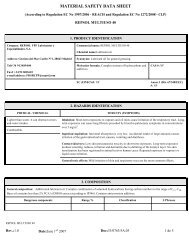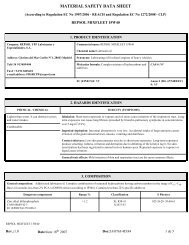REPSOL TURBOARIES 32
REPSOL TURBOARIES 32
REPSOL TURBOARIES 32
You also want an ePaper? Increase the reach of your titles
YUMPU automatically turns print PDFs into web optimized ePapers that Google loves.
MATERIAL SAFETY DATA SHEET<br />
(According to Regulation EC No 1907/2006 - REACH and Regulation EC No 1272/2008 - CLP)<br />
<strong>REPSOL</strong> <strong>TURBOARIES</strong> <strong>32</strong><br />
1. PRODUCT IDENTIFICATION<br />
Company: <strong>REPSOL</strong> YPF Lubricantes y<br />
Especialidades, S.A.<br />
Address: Glorieta del Mar Caribe Nº1. 28043 Madrid<br />
Tel# 34 913489400<br />
Fax# +34 913483610<br />
e-mail address: FDSRCPP@repsol.com<br />
Commercial name: <strong>REPSOL</strong> <strong>TURBOARIES</strong> <strong>32</strong><br />
Chemical name:Lubricant oil.<br />
Synonyms: Lubricant oil for turbines and compressors.<br />
Molecular formula: Complex mixture of hydrocarbons and<br />
additives.<br />
EC (EINECS)#: NP<br />
CAS #: NP<br />
Annex I (Dir. 67/548/EEC)<br />
#: NP<br />
2. HAZARDS IDENTIFICATION<br />
PHYSICAL / CHEMICAL<br />
Lighter than water. It can obstruct sewers<br />
and water intakes.<br />
Combustible.<br />
TOXICITY (SYMPTOMS)<br />
Inhalation: Short-term exposures to vapours and oil mists cause irritation of the respiratory tract. Longterm<br />
exposures can cause lung fibrosis preceded by broncho-pulmonary symptoms in concentrations<br />
over 5 mg/m 3 .<br />
Ingestion/Aspiration: Intestinal absorption is very low. Accidental intake of large amounts causes<br />
irritation of the gastrointestinal tract, nausea, vomiting and diarrhoea.<br />
Contact skin/eyes: Low skin percutaneous toxicity in short-term exposures. Long-term exposures<br />
produce smarting, redness, irritation and dermatitis due to defatting of the keratyn layer. No skin<br />
sensitization has been registered in animal tests or human cases. Repeated exposure to vapours or<br />
liquid cause irritation.<br />
General toxic effects: Mild skin irritation and respiratory tract irritation are the most common effects.<br />
3. COMPOSITION<br />
General composition: Additivated lubricant oil. Complex combination of saturated hydrocarbons having carbon numbers in the range of C 15 -C 50 .<br />
Base oil contains less than 2% PCA’s (DMSO extract according to IP346). Contains anticorrosion, antioxidant and antifoaming additives.<br />
Dangerous components Range % Classification S Phrases<br />
NP<br />
<strong>REPSOL</strong> <strong>TURBOARIES</strong> <strong>32</strong><br />
Rev.:1.1 Date:April 25 th 2011 Doc:33/0763/5G.10 1 de 5
4. FIRST-AID MEASURES<br />
Inhalation: In case of inhalation remove the victim to fresh air. Administer oxygen if necessary. Call for medical attention.<br />
Ingestion/Aspiration: Do not induce vomiting. If conscious have the victim drink water.<br />
Contact skin/eyes: Flush with plenty of water and soap. Flush with plenty of water during at least 15 minutes. Call for medical aid.<br />
General measures: Call for medical attention.<br />
5. FIRE-FIGHTING MEASURES<br />
Extinguishing agents: Foams, dry chemicals, CO 2 , water spray.<br />
Non suitable extinguishing agents: Water applied directly may be ineffective due to dispersion of the material.<br />
Combustion products: CO 2 , H 2 O, CO (in defect of air), SO 2 .<br />
Special measures: Not required.<br />
Special hazards: NP<br />
Protective equipment: Heat-resistant suit and gloves. Self-contained breathing apparatus.<br />
6. ACCIDENTAL RELEASE MEASURES<br />
Environmental precautions: Hazard of physical fouling to coasts,<br />
soils, etc, due to low solubility and high viscosity of the oils. Avoid<br />
the material entering water intakes.<br />
Cleanup methods: Treat as an accidental oil spill or leak; Avoid<br />
dispersion of the material with mechanical barriers. Remove with<br />
physical or chemical treatment.<br />
Personal precautions: Avoid prolonged contact with contaminated clothes<br />
or with the product and inhalation of vapours and mists.<br />
Personal protection: Suitable protective clothing, gloves and goggles<br />
should be worn during the clean up operation.<br />
7. HANDLING AND STORAGE<br />
Handling:<br />
General precautions: Avoid prolonged contact and inhalation of mists and vapours from heated oils. During transfer avoid contact with air, use<br />
pumps and connections properly earthed to prevent generation of electrostatic charges. The contaminated air should be filtered before discharge.<br />
Specific conditions: Safety goggles and gloves should be used. Do not weld or carry out any activity that could generate sparks in areas close<br />
to product storage. Do not weld in empty tanks without previous purging.<br />
Storage:<br />
Temperature and decomposition products: Carbon monoxide (toxic gas) and asphyxiants could be emitted at high temperatures by incomplete<br />
combustion.<br />
Dangerous reactions: NP<br />
Storage conditions: Containers properly labelled and sealed, placed in cool and well ventilated areas. Do not smoke, weld or do any work that<br />
can produce flames or sparks in storage area.<br />
Incompatible materials: Strong oxidants.<br />
<strong>REPSOL</strong> <strong>TURBOARIES</strong> <strong>32</strong><br />
Rev.:1.1 Date:April 25 th 2011 Doc:33/0763/5G.10 2 de 5
8. EXPOSURE CONTROLS/PERSONAL PROTECTION<br />
Personal protection:<br />
Eye protection: Safety goggles to avoid splashes.<br />
Respiratory protection: The product is slightly volatile at room<br />
temperature and does not present special risks. In presence of heated<br />
oils, wear protective masks to avoid vapour inhalation.<br />
Skin protection: Gloves (polyethylene, polyvinyl chloride and<br />
neoprene; do not use neither natural nor butyl rubber)<br />
Other protective equipment:Showers and eye-washers in the working area.<br />
General precautions: Avoid prolonged contact and inhalation of mists and vapours from heated oils. Local exhaust ventilation should be installed to<br />
capture and remove emissions near to the point of generation.<br />
Specific hygiene measures: Contaminated footwear should be discarded. Contaminated clothing should not be taken home for laundering. Regular<br />
changing of underwear is also important if penetration of outer clothing occurs. Disposable wipes should be used. Washing/Showering facilities with<br />
a non-solvent based skin cleaner, hot water and soap must be provided and used. Use skin reconditioning cream after work.<br />
Exposure controls: TLV/TWA (ACGIH): 5mg/m 3<br />
UK: OEL-TWA (COSHH): 5mg/m 3 ; OEL-STEL: 10mg/m 3 [Oil mist]<br />
9. PHYSICAL AND CHEMICAL PROPERTIES<br />
Appearance: Amber oily liquid.<br />
Colour: 1 (ASTM D-1500)<br />
Boiling point: > 400 o C (ASTM 1160)<br />
Flash point: 190 o C min. (ASTM D-92)<br />
Explosive properties: NP<br />
Vapour pressure: < 0.1 mm Hg at 25 o C<br />
Surface tension: NP<br />
Vapour density: NP<br />
Water solubility: Insoluble<br />
pH: NP<br />
Odour: Lube oil.<br />
Melting/Freezing point: -9 o C max. (ASTM D-97)<br />
Autoignition temperature: NP<br />
Oxidizing properties: NP<br />
Density: 0.870 g/cm 3 typical at 15 o C<br />
Viscosity: (100 ºC) 5.4 cSt typical<br />
(40 ºC) <strong>32</strong> cSt typical<br />
Partition coefficient (n-octanol/water): NP<br />
Solubility: Organic solvents.<br />
Other data: Fire point: 210 o C min. (ASTM D-92)<br />
10. STABILITY AND REACTIVITY<br />
Stability: Stable at room temperature.<br />
Conditions to avoid: Exposure to open flames.<br />
Materials to avoid: Strong oxidants react with oils and organic materials.<br />
Hazardous decomposition/combustion products: Carbon monoxide (toxic gas) and asphyxiants could be emitted at high temperatures by incomplete<br />
combustion.<br />
Polymerization risk: NP<br />
Conditions to avoid: NP<br />
<strong>REPSOL</strong> <strong>TURBOARIES</strong> <strong>32</strong><br />
Rev.:1.1 Date:April 25 th 2011 Doc:33/0763/5G.10 3 de 5
11. TOXICOLOGICAL INFORMATION<br />
Routes of exposure: Contact with skin, eyes and inhalation. Ingestion is not frequent.<br />
Acute and chronic effects: No malignant acute effects are known. Irritation by contact with liquid and prolonged inhalation of vapours or oil mists<br />
are the most common effects.<br />
LD 50 >15 g/Kg (oral-rat)<br />
LD 50 >5 g/Kg (skin-rat)<br />
Carcinogenicity: Base oil: IARC classification: Group 3 (The agent is not classifiable as to its carcinogenicity to humans)<br />
Reproductive toxicity: No evidences.<br />
Medical conditions which increase hazard to exposure: Respiratory tract deficiencies and dermatological problems.<br />
12. ECOLOGICAL INFORMATION<br />
Pollutant potential:<br />
Persistence and degradability:The material is oily and viscous and floats on water. It presents a high physical fouling potential, mainly in seaspills;<br />
by contact destroys small aquatic organisms and makes living difficult for upper organisms, not allowing the sunlight to reach underlying<br />
marine ecosystems, affecting its normal development. It is not readily biodegradable.<br />
Mobility/bioaccumulative potential:There are no data to indicate that the product is significantly bioaccumulated by aquatic organisms or<br />
incidence in the trophic food chain, although it may cause long-term adverse effects in the aquatic environment, due to its high physical fouling<br />
potential.<br />
Ecotoxicological effects: : LL 50 (Lethal loading)>1,000 mg/l (lubricant base oils). Dangerous for aquatic life in high concentrations (spillages).<br />
13. DISPOSAL CONSIDERATIONS<br />
Disposal methods (surplus): Recycling and recovery of base oils when possible.<br />
Waste: Liquids and solids from industrial process; do not attempt to clean containers since residue is difficult to remove; dispose in a safe way.<br />
Disposal: Only in specific prepared and controlled areas. Avoid releasing waste oils to sewers because they can destroy water treatment plant<br />
microorganisms.<br />
Handling: Labelled and sealed containers. Avoid direct contact with waste oils.<br />
Provisions: Companies which recover, dispose, store, transport or handle waste should comply with Dir. 2008/98/EC on waste, or other local,<br />
national or community provisions.<br />
<strong>REPSOL</strong> <strong>TURBOARIES</strong> <strong>32</strong><br />
Rev.:1.1 Date:April 25 th 2011 Doc:33/0763/5G.10 4 de 5
14. TRANSPORT INFORMATION<br />
Special precautions: Stable at room temperature and during transport. Store in cool well ventilated areas.<br />
Additional information:<br />
UN Number: NP<br />
Hazard identification number: NP<br />
Proper shipping name: NP<br />
ADR/RID: Not classified<br />
IATA-DGR: Not classified<br />
IMDG: Not classified<br />
15. REGULATORY INFORMATION<br />
CLASSIFICATION<br />
NP<br />
LABELLING<br />
Symbols: NP<br />
Phrases R<br />
NP<br />
Phrases S<br />
NP<br />
Other regulations: NP<br />
16. OTHER INFORMATION<br />
Data Bases consulted<br />
EINECS: European Inventory of Existing Commercial<br />
Substances.<br />
TSCA: Toxic Substances Control Act, US Environmental<br />
Protection Agency<br />
HSDB: US National Library of Medicine.<br />
RTECS: US Dept. of Health & Human Services<br />
R phrases/Hazard Class-and-Category shown in the document:<br />
NP<br />
Legislation consulted<br />
Globally Harmonized System of Classification and Labelling of Chemicals (GHS).<br />
Regulation (EC) no 1272/2008 of the European Parliament and of the Council of 16 December 2008 on classification, labelling and packaging of<br />
substances and mixtures (CLP).<br />
Regulation (EC) No 1907/2006 concerning the Registration, Evaluation, Authorisation and Restriction of Chemicals (REACH).<br />
Dir. 67/548/EEC about classification, labelling and packaging of dangerous substances (including amendments and adaptations in force).<br />
Dir. 1999/45/EC about classification, labelling and packaging of dangerous preparations (including amendments and adaptations in force).<br />
Dir. 91/689/EEC dangerous waste; Dir. 2008/98/EG waste management.<br />
Royal Decree 363/95: Regulation about notification of new substances and classification, packaging and labelling of dangerous substances.<br />
Royal Decree 255/2003: Regulation about classification, packaging and labelling of dangerous preparations.<br />
European Agreement concerning the international carriage of dangerous goods by road (ADR).<br />
Regulation on the international transport of dangerous goods on the railway. (RID)<br />
International maritime code of dangerous goods. (IMDG)<br />
International Air Transport Association (IATA) regulation pertaining to air shipment.<br />
Glossary<br />
CAS: Chemical Abstract Service<br />
IARC: International Agency for Research on Cancer<br />
ACGIH: American Conference of Governmental Industrial Hygienists.<br />
TLV: Threshold Limit Value<br />
TWA: Time Weighted Average<br />
STEL: Short-term Exposure Level<br />
REL: Recommendable Exposure Limit<br />
PEL: Permissible Exposure Limit<br />
INSHT: Instituto Nal. de Seguridad e Higiene en el Trabajo<br />
VLA-ED: Valor Límite Ambiental – Exposición Diaria<br />
VLA-EC: Valor Límite Ambiental – Exposición Corta<br />
LD 50<br />
: Lethal Dose Medium<br />
LC 50<br />
: Lethal Concentration Medium<br />
EC 50 : Effective Concentration Medium<br />
IC 50 : Inhibitory Concentration Medium<br />
BOD: Biological Oxygen Demand.<br />
NP: Not Pertinent<br />
| : Changes from the last revision<br />
The information given in this document has been compiled based on the best existing information sources, latest available knowledge and according<br />
to the current requirements on classification, packaging and labelling of hazardous substances. It does not imply the information is exhaustive or<br />
accurate in all cases. It is the user’s responsibility to determine the validity of the information contained in this Material Safety Data Sheet to apply<br />
depending on the case.
<strong>REPSOL</strong> <strong>TURBOARIES</strong> <strong>32</strong><br />
Rev.:1.1 Date:April 25 th 2011 Doc:33/0763/5G.10 5 de 5
















